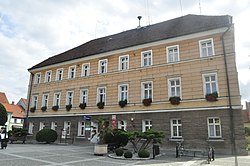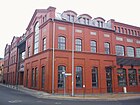Pleszew
Pleszew | ||
|---|---|---|
 Town hall | ||
|
Car plates PPL | | |
| Climate | Dfb | |
| Website | https://pleszew.pl/ | |
Pleszew ([ˈplɛʂɛf]) is a town in central Poland, in Greater Poland Voivodeship, about 90 km southeast of Poznań. It is the capital of Pleszew County. Population is 16,811 (2022).
History

The oldest permanent human settlements in the present-day Pleszew and its surroundings date back to the 9th century BC.

During the
| Year | Pop. | ±% |
|---|---|---|
| 1910 | 8,049 | — |
| 1921 | 7,638 | −5.1% |
| 1931 | 8,591 | +12.5% |
| 1939 | 9,994 | +16.3% |
| 1950 | 8,436 | −15.6% |
| 1960 | 11,035 | +30.8% |
| 2010 | 17,530 | +58.9% |
| Source: [4][5][6] | ||
In October 1918, a few weeks before Poland regained independence, local Poles began preparations for an uprising, which aim was to reintegrate the town along with the region of
On the day of the German
In August 1980, workers of the local automatic lathe factory joined the nationwide anti-communist strikes,[19] which led to the foundation of the "Solidarity" organization.
In 1983 the 700th anniversary of Pleszew was celebrated,[1] in reference to the first known historical mention of the town in 1283.
Sights
Among the historic sights of Pleszew are the Market Square (Rynek) with the Town Hall (Ratusz), the Regional Museum, the churches of Beheading of Saint John the Baptist, of Saint Florian and of the Holy Savior, and other historic buildings, including headquarters of historic organizations, townhouses and schools. There also numerous memorials at the sites of killings of Poles carried out by the Germans during the occupation of Poland.
-
High school
-
Church of the Beheading of Saint John the Baptist
-
Memorial stone in the Boreczek forest at the site of a German execution of 7 Poles in 1939
-
Narrow-gauge railway station
-
Shopping mall
Notable people
- Agnieszka (Lipska) Baranowska (1819–1890), Polish playwright and poet, wrote several plays for this town's local theater
- Moses Samuel Zuckermandl (1836–1917), Czech-German rabbi, lived here
- Stefan Pawlicki (1839–1916), Polish Catholic priest, philosopher, historian of philosophy; lived here
- Teodor Jeske-Choiński (1854–1920), Polish intellectual, writer and historian, literature critic
- Hugo Leichtentritt (1874–1951), German-Jewish musicologist and composer, born here
- Emil Jarrow (Javorzynski) (1876–1959), world touring vaudeville magician and comedian, born here
- Hanna Suchocka (born 1946), first female Prime Minister of Poland, born here
- Sergiusz Prusak (born 1979), Polish footballer, born here
- Maciej Piaszczyński (born 1989), Polish international speedway rider, born here
International relations
Twin towns — Sister cities
Pleszew is
See also
References
- ^ a b c d e f g h i j k "Skrót dziejów miasta". Pleszew.pl (in Polish). Retrieved 1 March 2020.
- ^ "Informacja historyczna". Dresden-Warszawa (in Polish). Retrieved 1 March 2020.
- ^ Gembarzewski, Bronisław (1925). Rodowody pułków polskich i oddziałów równorzędnych od r. 1717 do r. 1831 (in Polish). Warszawa: Towarzystwo Wiedzy Wojskowej. p. 26.
- ^ Wiadomości Statystyczne Głównego Urzędu Statystycznego (in Polish). Vol. X. Warszawa: Główny Urząd Statystyczny. 1932. p. 194.
- ^ Dokumentacja Geograficzna (in Polish). Vol. 3/4. Warszawa: Instytut Geografii Polskiej Akademii Nauk. 1967. p. 38.
- ^ Stan i struktura ludności oraz ruch naturalny w przekroju terytorialnym w 2010 r. (PDF) (in Polish). Warszawa: Główny Urząd Statystyczny. 2011. p. 105. Archived from the original (PDF) on 13 November 2011.
- ^ a b c d e "Pleszew (miasto powiatowe)". Instytut Pamięci Narodowej (in Polish). Retrieved 31 January 2021.
- ^ Englicht, Józef (1929). Zarys historji wojennej 70-go Pułku Piechoty Wielkopolskiej (in Polish). Warszawa. p. 23.
{{cite book}}: CS1 maint: location missing publisher (link) - ^ Wardzyńska, Maria (2009). Był rok 1939. Operacja niemieckiej policji bezpieczeństwa w Polsce. Intelligenzaktion (in Polish). Warszawa: IPN. p. 117.
- ISBN 978-83-88693-73-1.)
{{cite book}}: CS1 maint: location missing publisher (link - ^ Wardzyńska (2009), p. 201
- ^ "Na pleszewskich grobach zapłonął Znicz Pamięci". Pleszew Nasze Miasto (in Polish). Retrieved 1 March 2020.
- ISBN 83-85003-97-5.
- ISBN 978-83-8098-174-4.
- ^ Wardzyńska (2017), p. 231, 298
- ^ "Straf- bzw. Arbeitserziehungslager Pleschen". Bundesarchiv.de (in German). Retrieved 31 January 2021.
- ^ Encyklopedia konspiracji Wielkopolskiej 1939–1945. p. 147.
- ^ Encyklopedia konspiracji Wielkopolskiej 1939–1945. pp. 80, 433.
- ISSN 1641-9561.







